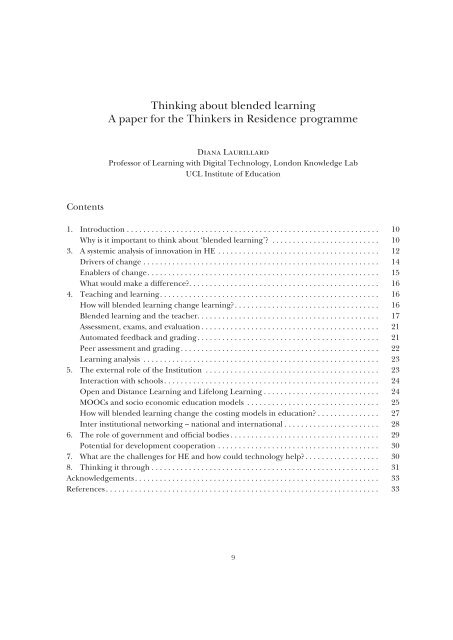Dillenbourg Higher education in the digital era
tw_blended-learning_en
tw_blended-learning_en
Create successful ePaper yourself
Turn your PDF publications into a flip-book with our unique Google optimized e-Paper software.
1. Introduction<br />
The aim of <strong>the</strong> project as def<strong>in</strong>ed by <strong>the</strong> KVAB is: <strong>the</strong> development of a systemic vision on <strong>the</strong><br />
optimal exploitation of ICT and <strong>the</strong> Internet for <strong>the</strong> new learn<strong>in</strong>g of <strong>the</strong> 21 st century.<br />
We were asked to produce a broad long-term vision paper on blended learn<strong>in</strong>g, <strong>in</strong>clud<strong>in</strong>g<br />
hypo<strong>the</strong>ses, possible models and future scenarios, on three levels: micro (learner, teacher, class),<br />
meso (<strong>in</strong>stitution, school) and macro (<strong>the</strong> policy makers, e.g. <strong>the</strong> <strong>education</strong>al networks and <strong>the</strong><br />
governments).<br />
The th<strong>in</strong>k<strong>in</strong>g articulated <strong>in</strong> this document is <strong>the</strong> result of <strong>the</strong> many conversations with my<br />
co-th<strong>in</strong>ker, Pierre <strong>Dillenbourg</strong>, <strong>the</strong> members of <strong>the</strong> KVAB Expert Group, and <strong>the</strong> staff of <strong>the</strong><br />
universities we visited over <strong>the</strong> past year. It has been a great opportunity to th<strong>in</strong>k, reth<strong>in</strong>k, and<br />
<strong>the</strong>n th<strong>in</strong>k aga<strong>in</strong> – and I hope we will all cont<strong>in</strong>ue to do that, because our chang<strong>in</strong>g technology<br />
environment demands us to do so.<br />
A simple def<strong>in</strong>ition of ‘blended learn<strong>in</strong>g’ is “<strong>the</strong> thoughtful <strong>in</strong>tegration of classroom face-toface<br />
learn<strong>in</strong>g experiences with onl<strong>in</strong>e learn<strong>in</strong>g experiences” (Garrison & Kanuka, 2004). It<br />
blends <strong>the</strong> campus-based with <strong>the</strong> onl<strong>in</strong>e. It must be ‘thoughtful’ because technology is complex<br />
and cont<strong>in</strong>ually chang<strong>in</strong>g. It must be a thoughtful ‘<strong>in</strong>tegration’ because <strong>the</strong> <strong>digital</strong> is not a<br />
supplement, and does not simply replicate aspects of <strong>the</strong> conventional – each should enhance<br />
<strong>the</strong> o<strong>the</strong>r.<br />
Blended learn<strong>in</strong>g means respect<strong>in</strong>g <strong>the</strong> true value of conventional methods – such as<br />
sem<strong>in</strong>ars, tutorials, projects, labs, field trips, physical materials. And it means acknowledg<strong>in</strong>g <strong>the</strong><br />
extraord<strong>in</strong>ary power and flexibility of <strong>digital</strong> technologies. How can <strong>the</strong> two be thoughtfully<br />
<strong>in</strong>tegrated to give <strong>education</strong> <strong>the</strong> power and flexibility it needs <strong>in</strong> order to play its proper role <strong>in</strong><br />
21 st century life?<br />
So my slightly modified def<strong>in</strong>ition of blended learn<strong>in</strong>g is: <strong>the</strong> thoughtful <strong>in</strong>tegration of<br />
conventional and <strong>digital</strong> methods of teach<strong>in</strong>g and learn<strong>in</strong>g as <strong>the</strong> means to achieve our greatest ambitions for<br />
21 st century <strong>education</strong>.<br />
2. Why is it important to th<strong>in</strong>k about ‘blended learn<strong>in</strong>g’?<br />
The <strong>in</strong>tegration of <strong>digital</strong> technologies with conventional methods of teach<strong>in</strong>g and learn<strong>in</strong>g<br />
is already a feature of higher <strong>education</strong> (HE). Integration is <strong>in</strong>creas<strong>in</strong>g rapidly, primarily because<br />
of <strong>the</strong> ubiquitous presence of <strong>digital</strong> technology and <strong>the</strong> <strong>in</strong>crease <strong>in</strong> <strong>the</strong> <strong>digital</strong> skills of both<br />
students and teachers.<br />
Digital technologies are br<strong>in</strong>g<strong>in</strong>g powerful changes to <strong>education</strong> systems, none of which are<br />
under <strong>the</strong> control of <strong>the</strong> academy. The <strong>in</strong>creases <strong>in</strong> access to devices and communications, <strong>in</strong><br />
students’ <strong>digital</strong> lit<strong>era</strong>cy, <strong>in</strong> private providers’ development of learn<strong>in</strong>g environments, and <strong>in</strong> free<br />
onl<strong>in</strong>e resources, change <strong>the</strong> ways <strong>in</strong> which students access and learn concepts and skills. These<br />
are powerful forces and <strong>the</strong>y will change <strong>education</strong> with or without <strong>the</strong> <strong>in</strong>volvement of academics.<br />
Better that <strong>the</strong> academy engage and lead than avoid and perish.<br />
10


